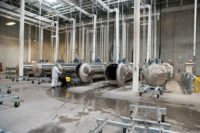Fabulous Food Plant: Cultures Converge at Commonwealth Dairy


The fermentation room is the most sensitive area of a yogurt plant. Frequent sampling and lab testing deliver quality assurance and a safeguard against wasted batches. Source: Tobias Gelston.

The packaging area requires manual inputs, though automation will minimize them in the future. Source: Tobias Gelston.

A clean-room zone in the yogurt fillers minimizes contamination risk and helps push shelf life to 60 days without preservatives. Source: Tobias Gelston.

Maintenance Manager Daniel Frommel accesses a burned-out fluorescent tool in the dairy’s walkable ceiling area. Light fixtures, piping and equipment not needed on the production floor are isolated in the interstitial area above the ceiling and below the roof, improving plant hygiene. Source: Kevin T. Higgins.

Push water for filler line evacuation is pasteurized in a UV system, eliminating the energy requirements of thermal pasteurization. Sensors monitor turbidity and UV intensity (foreground), while a mass flow meter (background) regulates water flow rate. Source: Tobias Gelston.

Colored control-top lights provide at-a-glance status reports on mix-proof valves: green for open and amber for closed; a red light triggers a maintenance call. Source: Tobias Gelston.







Keep it clean
Upgraded filler specs
For more information:
Bigger bangs with VFDs, LEDs, et al.Relegating a year-old compressor to backup duties would make most manufacturers cringe. But based on detailed analysis by consulting engineers from Efficiency Vermont, Commonwealth Dairy did just that, confident the eight-month ROI calculation would pan out.
Commonwealth is one of 69 energy-intensive operations in the state participating in Efficiency Vermont’s (EV) Energy Leadership Challenge, a program targeting 7.5 percent reductions in energy per unit of production. Even before the challenge kicked off, Commonwealth officials invited EV’s energy consultants to review the plant’s infrastructure and suggest improvements. Subsidies in the 10 to 20 percent range are provided when manufacturers upgrade their systems, but the greater value is the payback analysis EV auditors provide for technologies the manufacturer may not have considered, according to Chuck Clerici, EV’s business development specialist.
“The single largest upgrade that made a major dent in the dairy’s achievement of the 7.5 percent target was the installation of a water-cooled chiller” for the refrigeration system, rather than the air-cooled chiller originally planned, says Clerici. Related to that investment was the replacement of the original compressor with a VFD-equipped unit.
At EV’s recommendation, Commonwealth specified VFDs for every motor larger than 1hp. Another upgrade being considered is the replacement of T-5 fluorescent lighting with LED technology, a capital investment that is beginning to yield an attractive ROI while also eliminating disposal and possible contamination of mercury, a risk abhorrent in food production.
“More than anything, engineers want things to work, and if they work efficiently, that’s just gravy,” Clerici reflects. Demonstrating that technologies such as VFDs and LEDs won’t compromise performance or reliability is just as important as outlining savings from reduced maintenance and energy consumption in convincing manufacturers to upgrade infrastructure. “Energy efficiency is not the only consideration,” he adds.
EV is an example of a usage-reduction program that is decoupled from utility companies. Electric customers throughout the state are assessed a surcharge on monthly bills to fund EV’s $35 million annual budget.
|
Looking for a reprint of this article?
From high-res PDFs to custom plaques, order your copy today!











